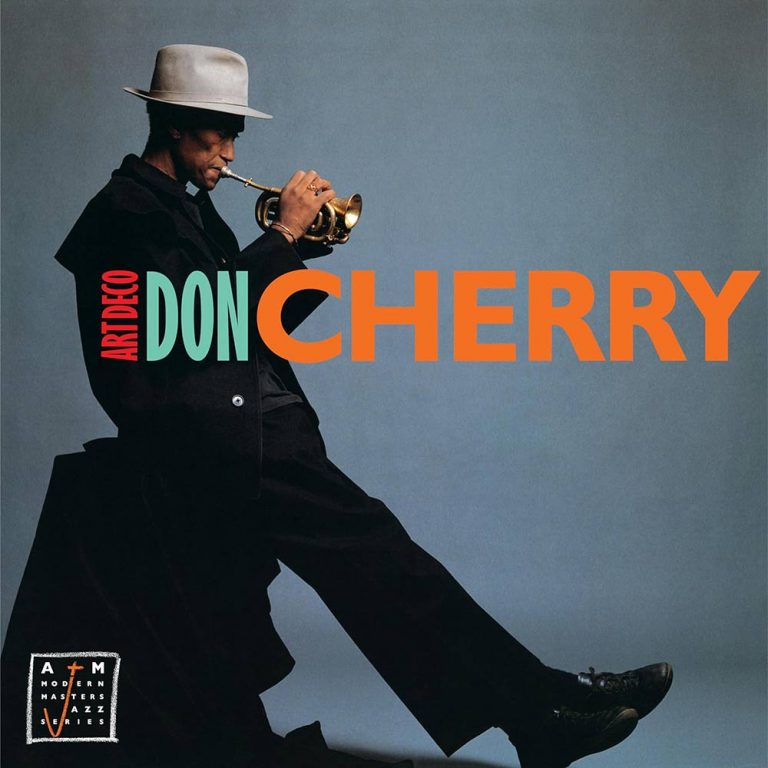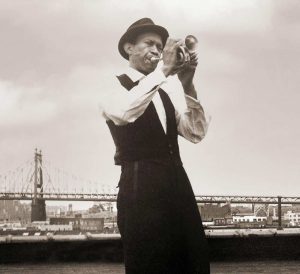As one of the last albums Cherry recorded before he passed away in 1995, “Art Deco” could be considered something of a return home – or at least a glance back over the shoulder.
By 1988, the non-conformist trumpeter had been travelling the planet for about three decades, absorbing folk music of all styles, which led to collaborations with a wide variety of musicians. From South African pianist Abdullah Ibrahim and Indian tabla player Latif Khan, to Swedish drummer Bengt Berger, as well as the top echelon of international jazz musicians, Cherry and his pocket trumpet were constantly on the road.
You might say it was Ornette Coleman’s harmolodic theory – a liberating principle that created more freedom in the song structure – that opened up Cherry’s musical universe. Coleman’s spirit has always been there alongside Cherry’s nomadic impulses, not least on “Art Deco.” Cherry had been weaving his way freely through a post-bop sound palette as part of the group Old and New Dreams in the late 1970s – essentially Coleman’s acoustic quartet with bassist Charlie Haden and drummer Ed Blackwell, with saxophonist Dewey Redman in place of Coleman.

DON CHERRY Art Deco
Available to purchase from our US store.In 1987 Cherry had also joined a reunited 1959 Coleman quartet on Coleman’s album “In All Languages,” which saw Haden and Cherry together with drummer Billy Higgins play one half of the double album, in contrast to Coleman’s electric group Prime Time.

Against this backdrop, “Art Deco” is a natural continuation but with a twist. Cherry, Haden and Higgins were joined for the three day recording session at Englewood Cliffs by Texan tenorman James Clay, and the reunion is a special one. Clay had played with Cherry and Coleman long before “The Shape Of Jazz To Come,” and Cherry considered Clay one of his strongest influences. Despite Clay’s relative obscurity and the fact that he’d only recorded a handful of times in the 1980s, notably for Higgins’ album “Bridgework,” the saxophonist was in top form during those late August days at Van Gelder’s studio. The chemistry of the group is palpable: They’re all on the same page, the playing is laid back but vital, and several of the versions here could be considered definitive.
While Coleman’s influence can clearly be felt on “Art Deco” – three of the compositions are his, and the group really hits its stride on them – it’s very much a group outing. In keeping with Cherry’s approach to band dynamics, the typical leader/sideman relation doesn’t really apply, and the setlist is also neatly balanced between players. Haden delivers a moving rendition of his composition “Folk Medley,” and both his and Higgins’ piece “Passing” compliment Cherry’s own solo trumpet song “Maffy.” Clay is given acres of space to blow, especially over the two ballads “Body and Soul,” and Lerner and Loewe’s “I’ve Grown Accustomed To Your Face.” The title track is Cherry’s own, but even on that slice of loose bop, it’s the group that really shines. Each member is even given space to write on the vinyl liner notes, with Haden especially honoured to play with “the great tenor player” he’d heard so much about.
Speaking to the New York Times when “Art Deco” came out, Cherry said that the American record business had always packaged him as a pure jazz artist, whereas he wanted more freedom, and wanted to record a second album for A&M. The result was 1991’s “Multikulti”, a gloriously broad-minded fusion with many more players and different instrumentation on nearly every track. It’s a stark contrast to its predecessor “Art Deco,” which seems laser-guided in comparison. But although the limitations on “Art Deco” reigned in Cherry’s adventurous spirit, it concentrated the record sonically and stylistically.
With “Art Deco,” Cherry brought his free-spirited approach to the post-bop group configuration one last time. While the sound is perhaps narrower than he would have liked, the result is a worldly-wise and joyous celebration of his roots. As they say, after some travels to faraway lands, you can appreciate coming home that much more, even for the briefest of spells.

DON CHERRY Art Deco
Available to purchase from our US store.Max Cole is a writer and music enthusiast based in Düsseldorf, who has written for record labels and magazines such as Straight No Chaser, Kindred Spirits, Rush Hour, South of North, International Feel and the Red Bull Music Academy.
Header photo: Don Cherry playing his pocket trumpet on a rooftop. Queens, New York City. 1983. Photo: Ira Berger/Alamy


